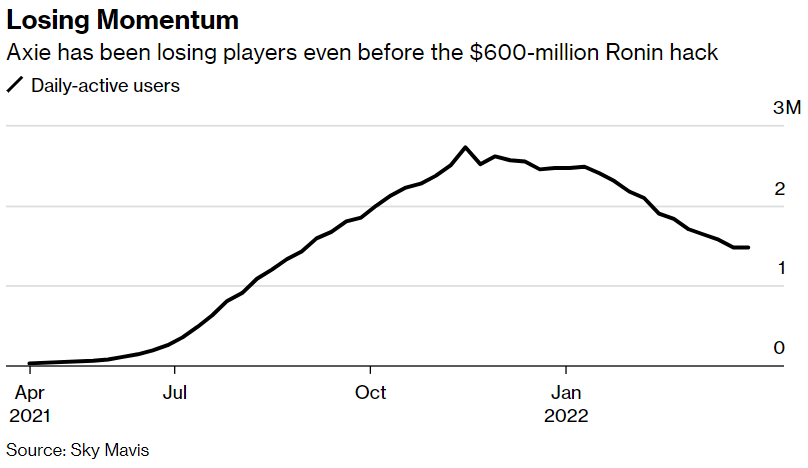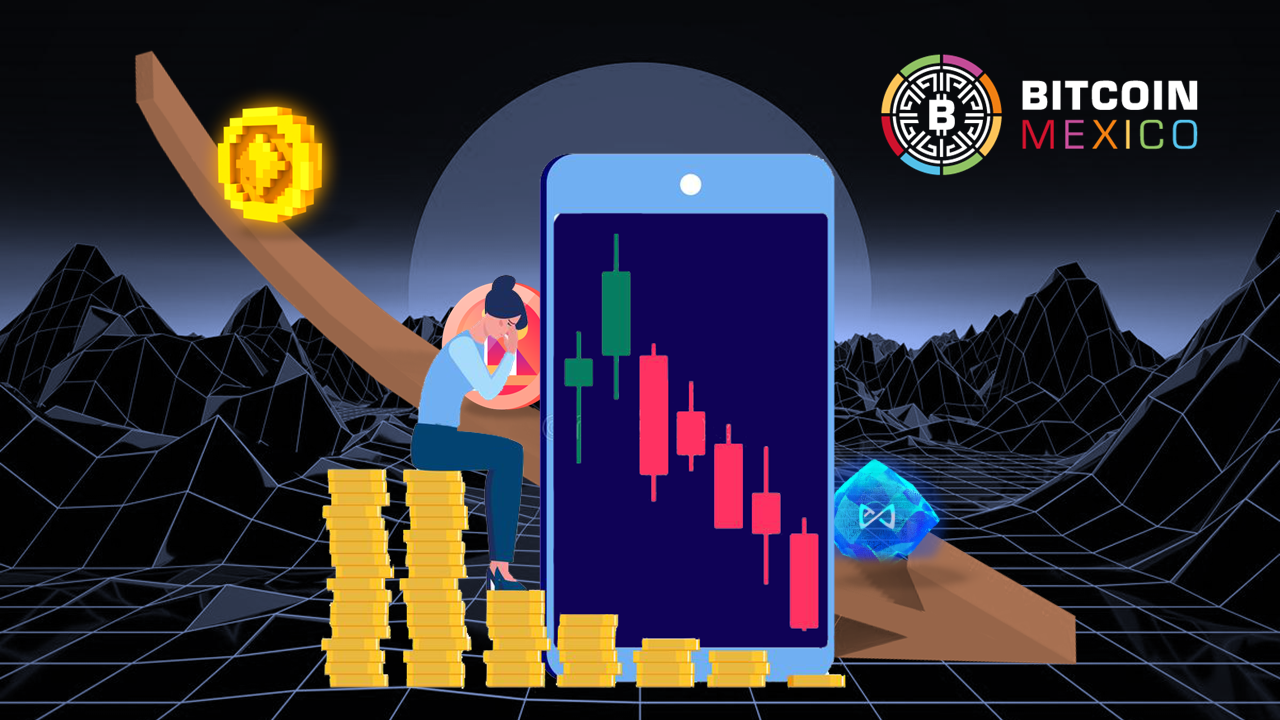Last week, the Axie Infinity game announced a record crypto theft on its platform and forced them to block the withdrawal of gamers to control the situation. While this solution disappoints many gamers, in fact, the player count of this hit game has plummeted since before this hack took place.
According to data extracted from a report by Sky Mavis, owner of Axie Infinity, the daily player count of this game has dropped by 45% from the peak of November 2021, to only 1.48 million. /day. The latest figures were recorded in the last week of March, just one day before the $600 million hack was discovered.

Axie Infinity’s daily player count has plummeted compared to November 2021
But not only Axie Infinity, even the GameFi ecosystem (the game model for earning crypto to earn real money) of BSC (Binance Smart Chain) is also facing the same problem. In an effort to turn itself into a platform for GameFi decentralized applications, from August to December 2021, hundreds of monetized game projects have fueled the network’s outstanding user growth. this.
However, starting in December 2021, daily users on BSC also plummeted from a peak of 480,000 on December 7, 2021 to just 180,000. By March 23, BSC’s daily user base was between 120,000 and 200,000.
Did GameFi fail?
But when the number of users of the current top games in the GameFi trend is going down, is that a sign that the GameFi trend has lost its place?
According to Mr. Phan Duc Trung, Chairman of DeCom Holdings, a fund that invests in and seeks solutions for decentralized financial technology (DeFi), there are two main reasons for the sharp and simultaneous decline. User count of GameFi model titles as of December 2021:
The first factor to consider is the volatility of the cryptocurrency market. Do”closely tied to the crypto market, we could see a drop in the price of Bitcoin from nearly $69,000 now around the $40,000 mark. The crypto market is having this seasonal sideways correction, which has been forecast since 2021” Mr. Trung said.
Followed by a general decline of the entire cryptocurrency market, including the cryptocurrencies used in GameFi titles.

Mr. Phan Duc Trung, Chairman of DeCom Holdings
An example of this is the price of SLP and AXS coins, the coins used in Axie Infinity, which have steadily declined since December. Following that is the daily income of players and their interest in the game also decreases.
Moreover, according to Trung, a more important cause of the decline of the GameFi trend is the saturation in gameplay and how users interact with the game – or “GameFi inflation”:
“The value provided by GameFi starting with play to earn is a different value to traditional game value like pay-to-play or game as service. The traditional game market also covers user devices from PC, Mobile to Console from online to offline. So GameFi just started from a very small online land, mostly web interaction, there are a few mobi interactions, but massively developed by game developers, leading to GameFi inflation by issuing good tokens. NFT inflation in diversity.“
“This is like TV drama inflation, but even if the TV channel runs 24/7, it won’t show all the movies. Not to mention due to the rapid development of GameFi, so over 90% of GameFi is probably the same and boring for players.”
“In order for the market to develop stably, it is necessary to have well-known traditional game developers participate to increase the attractiveness of games as well as offset the game as service models (turning games into subscription services) in community development. or entice businesses to convert to gamification. This will take time, not fast. I think that in the coming period support tools will help users understand the value-creating properties of NFT in games, it will make more sense for pay-to-play users. ).”

Does GameFi have a future?
Although he admits that the drop in Axie Infinity’s player base will have a negative impact on current GameFi projects, Trung said that the hardest hit will be fake games, copy games or buggy games.
“The demise of the trend of game copy game copy or game error is correct. The player market is still there but they demand a higher value. It will be an opportunity for the intersection of traditional game publishers with professional blockchain developers.”
“GameFi projects in Vietnam are mostly spontaneously released from game publishers or pure blockchain. There is not yet and it is difficult to have good coordination between groups of companies that are strong in games and blockchain to work together. Therefore, the decline of this market is inevitable and presents challenges for all development teams.”
This is evidenced by the fact that a series of Vietnamese GameFi projects, although with high expectations, later saw the token price drop by 80% – 90% after its launch.
Not only technical difficulties, GameFi Vietnamese projects also face other difficulties in the legal environment when the game business is still under strict management, so “There are software companies like Whydah or Sky Mavis, they can only develop blockchain application code in Vietnam, and distribution still has to go through foreign partners.” Mr. Trung said.

However, Trung remains optimistic about the future of GameFi, especially when placing it in the context of the growing Metaverse.
“GameFi is now just a small part of the Metaverse world in development. Let’s look at the inevitable and complete development of Metaverse to see which direction GameFi goes. It’s not just tokens or VR or AR hardware. Looking at the Metaverse world, it requires GameFi, NFT games and gamified bussiness. Metaverse will need a fuller connection than hardware, software and people” Mr. Trung said.
Besides, Mr. Trung still expects the combination of GameFi and traditional games in the future.
“The cross between traditional games and GameFi, it is the right direction for the new stage of GameFi. To be honest, I still play traditional games and try to find value in NFT games and tokens are just a tool in the pure crypto world from my personal point of view..”
This shows that the current decline of GameFi may just be a temporary setback until it finds a better direction for itself to explode in the future. The same thing happened with the crypto world when it went through many ups and downs to reach its current popularity.
